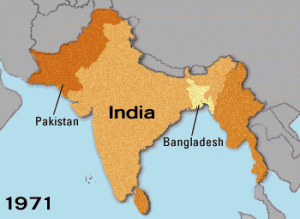Today’s post is the fifth in a six-part series reviewing the historical and current context of education in Pakistan. These posts include:
- Introduction
- Ancient India – Hindu and Buddhist Influences
- Islamic Influences
- British Influences
- A Separate Nation (this post)
- Education in Present-Day Pakistan

In 1947, India was partitioned into India and Pakistan – including West Pakistan and East Pakistan. In 1971, East Pakistan separated from Pakistan to form its own country, Bangladesh.
A Separate Nation
Over the centuries, India – including present-day Pakistan – has been shaped by a range of Hindu/Vedic, Buddhist, Islamic, and British social, cultural, and political influences. In the 1900s, Pakistan split from India to form its own nation, leading it to create its own identity and narrative, shaped by events as well as by ideologies and politics.
Partition of India
In the mid-1940s, when India was moving towards Independence from British rule, Muslims in the country feared being marginalized in an independent India made up of a majority Hindu population. Strong efforts by prominent Muslims – with important leadership provided by Muhammad Ali Jinnah – convinced the British to divide India into two countries before withdrawing. Hindu-majority regions were to be made part of India, and Muslim-majority regions were to be made part of a new country named ‘Pakistan’. Borders were drawn through the country – through provinces in some cases, and even through villages.
On August 14, 1947, the nation of Pakistan was officially formed, and on August 15, 1947, the British withdrew. This led to the largest migration in history – an estimated 12 to 15 million people crossed the new India-Pakistan border in hopes of joining the country where they felt they would belong and be safe with regards to religion. However, the migration and resettlement process was fraught with (and sometimes instigated by) horrific violence, and it is estimated that at least a million people were killed in conflicts between Hindus, Muslims, and Sikhs at this time. Initially, Pakistan was made up of two distinct parts – East Pakistan and West Pakistan, until a civil war in 1971 when East Pakistan separated to form its own country – Bangladesh.
Muhammad Ali Jinnah played a fundamental role in establishing Pakistan as a separate country, and he was the first Governor General of the new country. Jinnah continues to be revered in present-day Pakistan as ‘Quaid-e-Azam’ (Great Leader), and is considered the father of the nation in the narrative of Pakistan’s history which permeates Pakistani society – including school curricula.
Enduring Religious and Political Tensions
Unresolved conflict and distrust between India and Pakistan remain strong to this day. The countries have fought at least three wars since Partition. It is difficult for citizens of one country to visit the other. Hindu families who stayed behind in Pakistan at the time of Partition faced – and continue to face – suspicion and discrimination from the Muslim majority.
As well, many of the Muslim Urdu-speaking immigrants (Mohajirs) who arrived from the Indian side over to the Pakistani side settled in the province of Sindh – mostly in the city of Karachi. To this day, some antagonism exists between ethnic Sindhis and ethnic Mohajirs.
Initially, religious minorities were granted protections and rights by Pakistani constitution and society. However, over time, Pakistan’s narrative, ideology, and school curricula have increasingly emphasized the country’s identity as an Islamic country and the identities of Pakistanis as Muslims, with diminishing tolerance towards non-Muslims and even minority sects within Islam.
Current Demographics
Present-day Pakistan covers a broad and diverse geographic region. It is bordered by India, China, Afghanistan, and Iran, as well as the Arabian Sea which provides access to the Middle East and beyond. Pakistan’s population includes over 180 million people from several different ethnic groups. In addition, millions of refugees from neighbouring countries such as Afghanistan live in Pakistan. About 97% of the population is Muslim. Just over a third of the population lives in urban areas. While people in different provinces of Pakistan speak over 60 different languages, Urdu is the national language, and English is used as the official language for most government, legal, corporate, and civil society matters.
Next: See my next post for a more focused look at education in present-day Pakistan, as it has been influenced by historical and current contexts.
Please share your thoughts and comments below.
Sadaf Shallwani
See related posts: